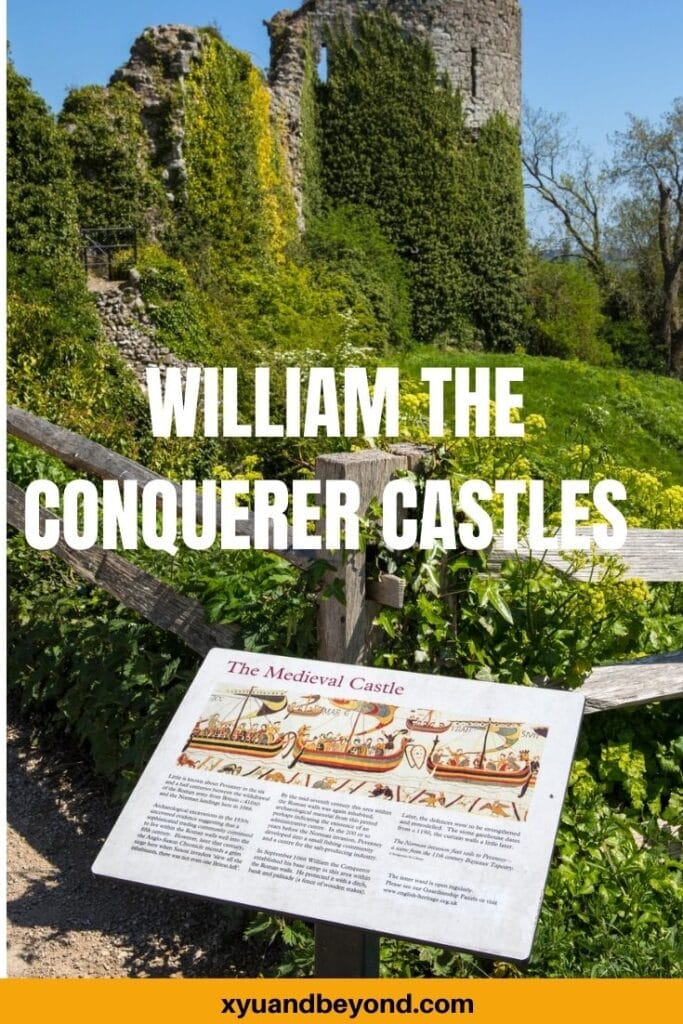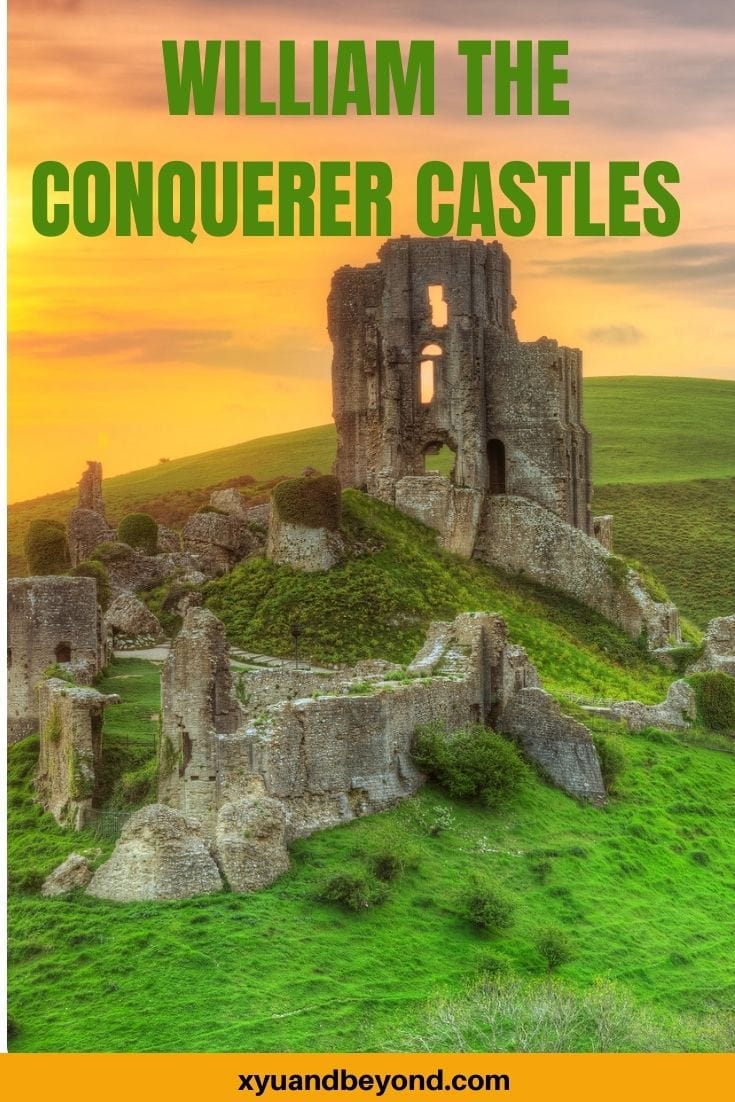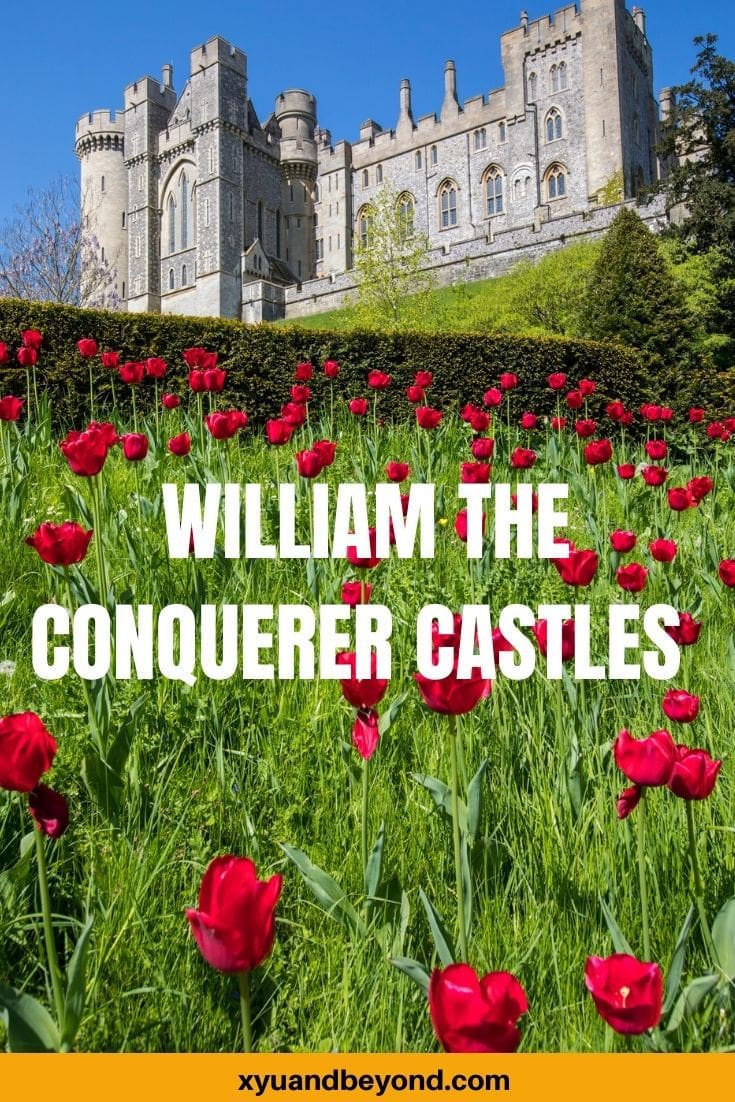William the Conqueror’s Norman Castles
Guillaume le Conquerant – otherwise known in England as William the Conqueror and sometimes William the Bastard reigned England from 1066 until 1087. William the Conqueror’s Norman Castles numbered over 700 were built during that time and they were spread all over England and Wales.
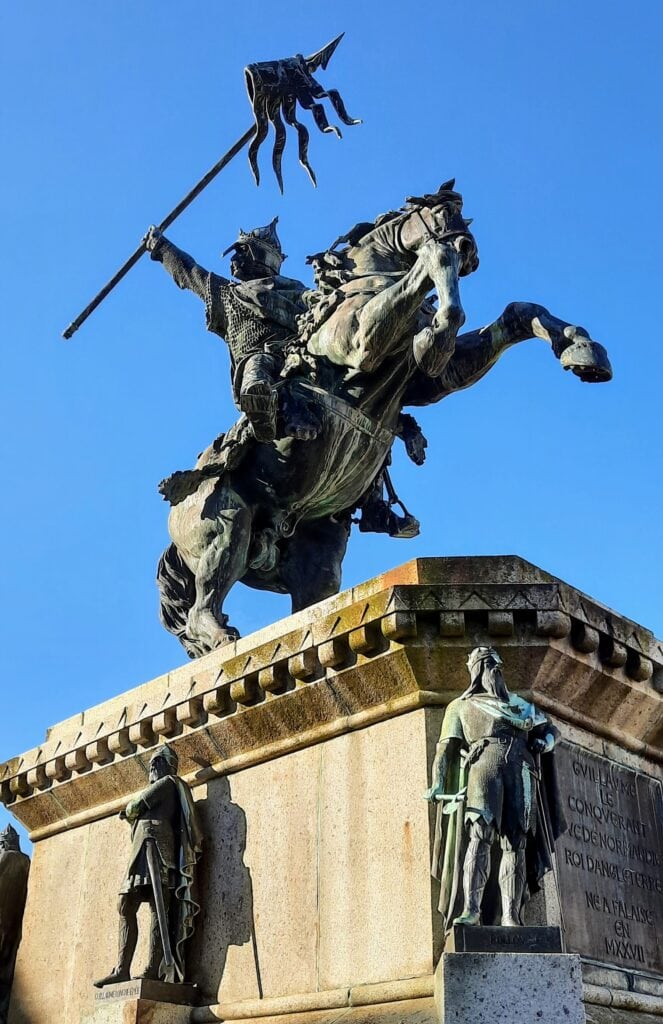
How many castles did William the Conqueror build? It is thought that the Normans built 500 motte and bailey castles followed by the motte and keep castles in the first 20 years after the Battle of Hastings. 90 of these historic Norman Castles still exist in England today.
Is William the Conqueror a Viking? William was the first Norman monarch of England, and descendant of Rollo the Viking and was Duke of Normandy, France from 1035. He held onto his domain in Normandy after a long struggle and when Edward the Confessor died William invaded England in 1066.
The Battle of Hastings in 1066 and William’s struggles to retain power are beautifully documented in the Bayeux Tapestry. King Harold’s reneging on his oath, the journey to the English shores and the battle are all depicted in this incredible work of art now in Bayeux Cathedral.
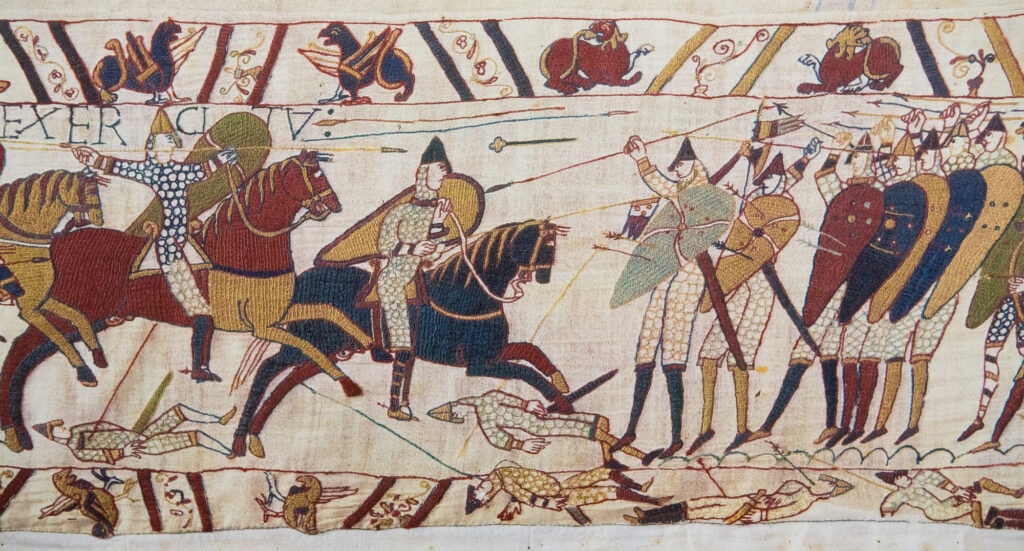
The Norman conquest of England by William also began a period of castle building that has left its mark on England to this day. You can visit many of William the Conqueror’s Castles in England and in particular when visiting France you can see the Castle where it all began.
Castles were not only military fortifications they were also homes for their noble owners, and protection for the villagers and peasants that farmed the land they were powerful symbols of the authority of the lords who built them.
When William the Conqueror took power in England he began a campaign of castle building to ensure his new kingdom knew who ruled.
- William the Conqueror's Norman Castles
- Frequently Asked Questions about Norman Castles of William the Conqueror in England
- 1. What is the significance of Norman castles built by William the Conqueror in England?
- 2. How many castles were built by William the Conqueror?
- 3. What is the architectural style of the Norman castles built by William the Conqueror?
- 4. Why did William the Conqueror choose to build castles in England?
- 5. How did the Norman conquest of England influence castle building?
- William the Conqueror Facts
- Castles of William the Conqueror map
- How William the Conqueror changed England
- Castles of William the Conqueror
- 14 English Norman castles
- How many Norman castles are there in England?
- Hastings Castle – East Sussex
- Rochester Castle – Kent
- Pevensey Castle – East Sussex
- Dover Castle – Kent
- The Tower of London – a Norman Keep
- Windsor Castle – Berkshire
- Norwich Castle – Norfolk
- Warwick Castle – Warwickshire
- York Castle – Clifford’s Tower – York
- Arundel Castle – West Sussex
- Chepstow Castle – Monmouthshire
- Colchester Castle – Essex
- Durham Castle – Durham
- Corfe Castle – Dorset
- Frequently Asked Questions about Norman Castles of William the Conqueror in England
Frequently Asked Questions about Norman Castles of William the Conqueror in England
1. What is the significance of Norman castles built by William the Conqueror in England?
The Norman castles of William the Conqueror in England were key strategic fortifications constructed during the Norman Conquest of England in 1066. These castles played a crucial role in William’s control over the newly conquered territory.
2. How many castles were built by William the Conqueror?
Several castles were built by William the Conqueror in England following his victory in the Battle of Hastings. Among the most famous are the Tower of London, Windsor Castle, Hastings Castle, and Norwich Castle.

3. What is the architectural style of the Norman castles built by William the Conqueror?
The Norman castles were typically characterized by motte and bailey structures, consisting of a raised earth mound (motte) with a wooden or stone keep on top, surrounded by a defensive ditch and enclosed courtyard (bailey).
4. Why did William the Conqueror choose to build castles in England?
William the Conqueror ordered the construction of castles in England to solidify his control over the newly conquered territory, establish a visible presence of his authority, and defend against potential rebellions and invasions.
5. How did the Norman conquest of England influence castle building?
Following the invasion of England, King William embarked upon a series of Motte-and-Bailey castles along the south coast of England. The first castle was built to the west, with William’s Castle developed as the first castle within his new realm. These early castles were primarily made of wood, with a wooden keep built atop a raised mound.
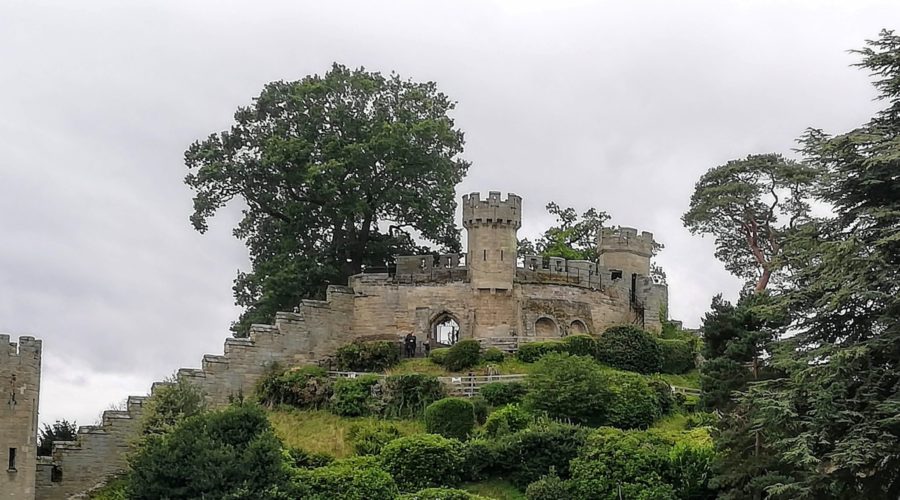
As William continued to control his new realm, a number of castles were constructed using Norman castle architecture. The hallmarks of Norman castle design were evident in the exterior of the castle, with stone keep castles built of Kentish Ragstone becoming prevalent. William’s other castles were built strategically to further cement his power.
William the Conqueror Facts
William the Conqueror was a descendant of the Viking Rollo. He was born in 1028 in Normandy France, but because he was the son of Duke Robert I and his Mistress Herleva the daughter of a tanner he was known as also known as ‘William the Bastard’.
Although his illegitimacy caused several issues later in his life he was the only male heir and so he inherited the title of Duke at the age of 8.
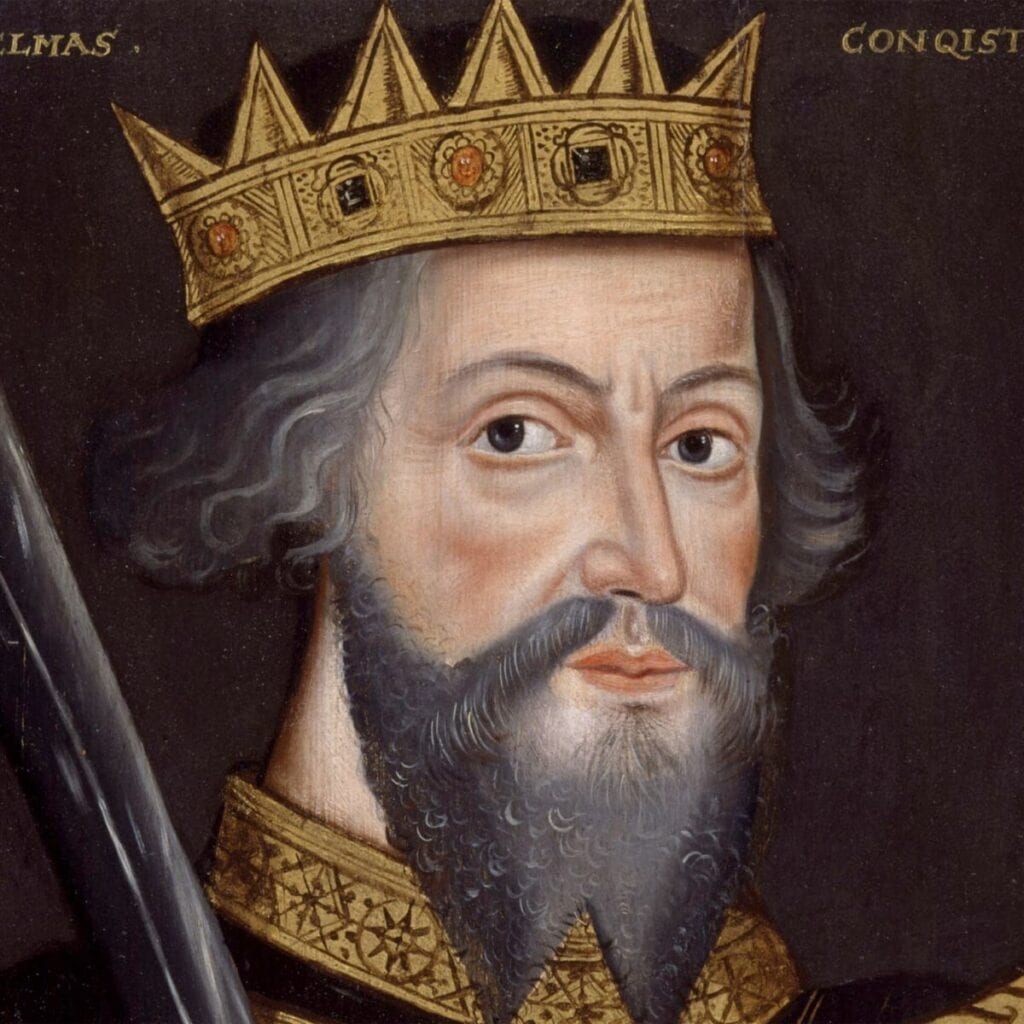
His Great Uncle was regent given William’s young age but the death of his great uncle in 1037 meant that warring factions who wanted to act as Regents caused chaos in the region.
By 1047 William was an adult and he defeated a rebellion against him but spent the next 7 years defending his rule and constantly at war. It wasn’t until 1060 that he had consolidated his power and overcome the rebellions against him.
In 1049 William negotiated with Baldwin V of Flanders for the hand of his daughter Matilda and the wedding (apparently against Matilda’s will) took place in 1053. The Pope was against the marriage as it was said that it was an incestuous match as the couple were somehow related.
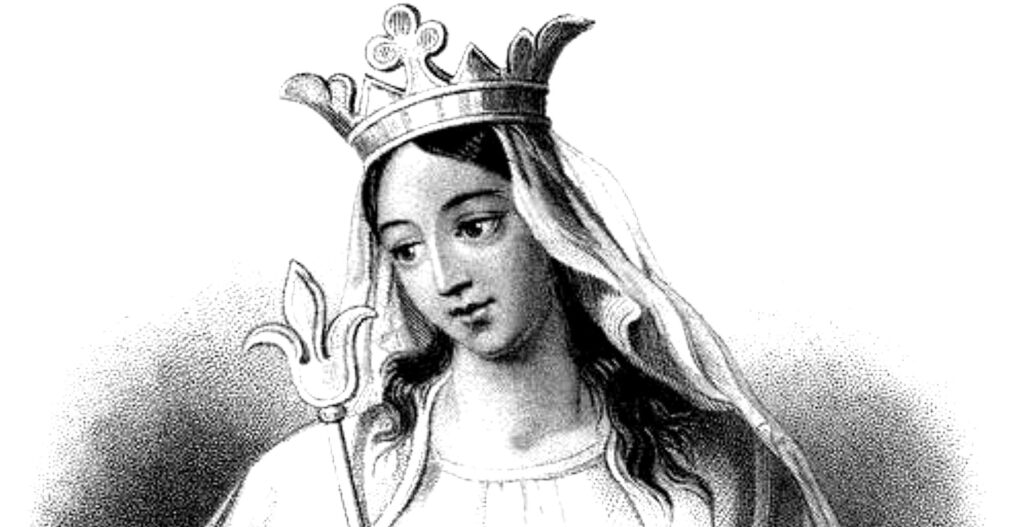
By 1059 William and the Pope reconciled and William was told to build monasteries at Caen in penance. The marriage produced four sons Robert (the future Duke of Normandy), Richard (who died young), William Rufus (his father’s successor in England), and Henry (Rufus’s successor). Among the daughters was Adela, who became the mother of Stephen, king of England from 1135 to 1154.
William had a legitimate claim to the English throne as King Edward the Confessor appointed him as his heir in 1051. In 1066 when King Edward died the Anglo-Saxon council of England decided to make Harold Godwinson King of England. Harold’s family had ties to Cnut the Great and so was considered to be Edward’s closest heir. Harold was probably the first English King to be crowned in Westminster Abbey.
In late September of 1066, King Harold defeated an invasion by Harald Hardrada of Norway in York and then marched to meet William the Conqueror at Hastings two weeks later.
William’s task at this point after winning at Hastings was how to control England and its rebellious nobles. In 1068 the Earls of Mercia and Northumbria revolted and in 1069 Edgar the Ætheling rose to attack William with the aid of the king of Denmark.
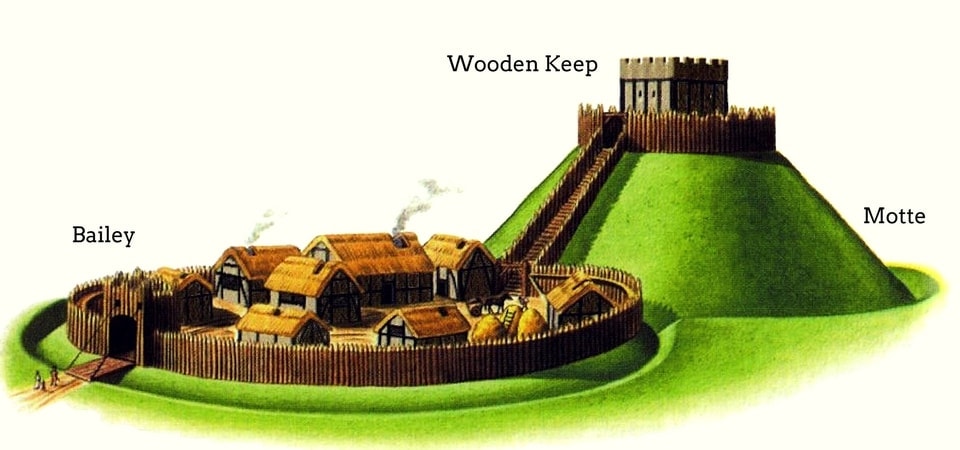
William had to come up with a way to defend himself and counter the potential rebellions by proving his military might and impressing his new subjects with his power and wealth. The answer to that lay in the building of Castles. William decided to embark on a very ambitious Castle building scheme.
William chose important towns and areas to build his castles including York, Windsor and other important locations across England. The majority of these castles were simple wooden motte and bailey constructions but were soon converted to impressive stone keeps.
Castles of William the Conqueror map
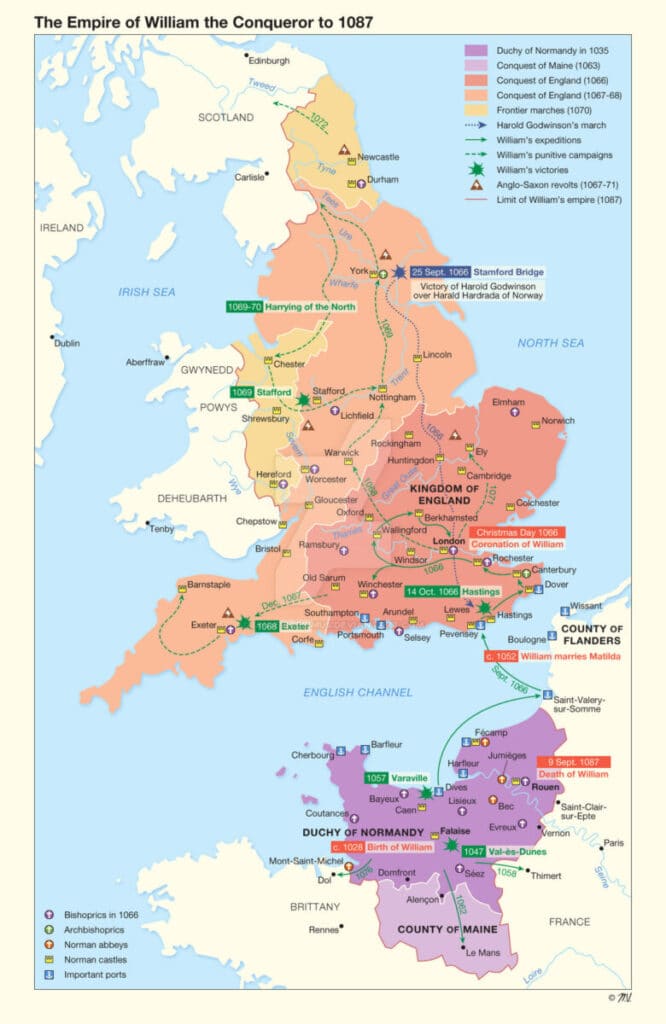
How William the Conqueror changed England
He changed the language of England from Anglo-Saxon to French. William spoke no English so when he won the battle at Hastings he proclaimed the official language as French. A third of all English words come from French and another third from Latin through French.
William ensured that Churches were restructured and brought powerful monastic communities to England. Existing Anglo-Saxon Bishops were replaced with Norman ones and many dioceses’ were relocated to urban centres.
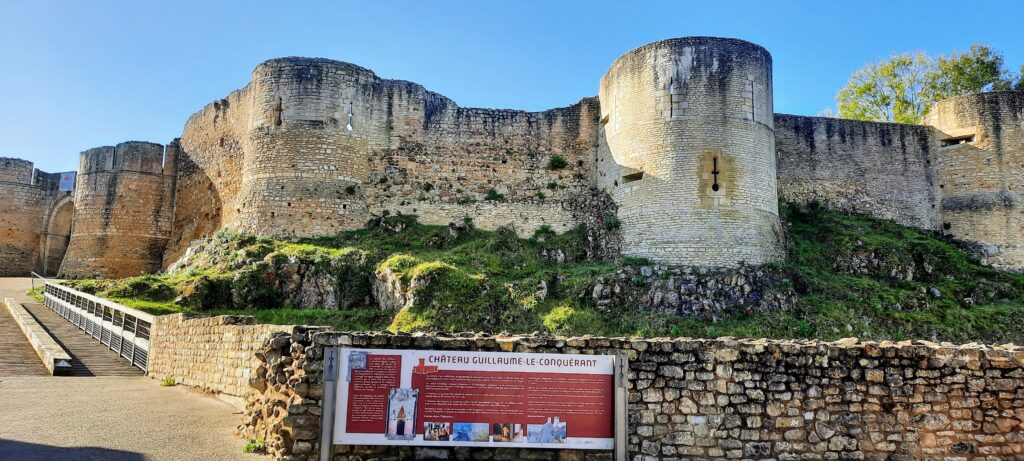
He introduced architecture in the form of motte and bailey castles and re-shaped warfare in England. and Romanesque cathedrals, feudalism became much more widespread,
William replaced the Anglo-Saxon landowning elite with his Norman allies.
The Domesday Book was created which is a detailed and systematic catalogue of the land and wealth in England.
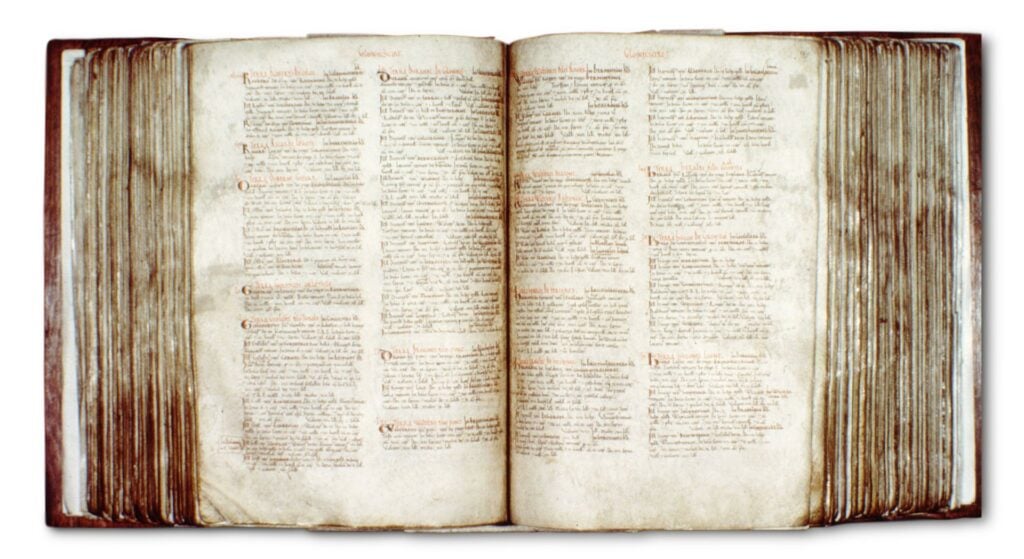
Castles of William the Conqueror
William’s building of castles began as soon as he arrived in England. Windsor Castle was first built by William and is the biggest inhabited castle in the world. There are many more of William the Conqueror’s castles across England including the Tower of London.
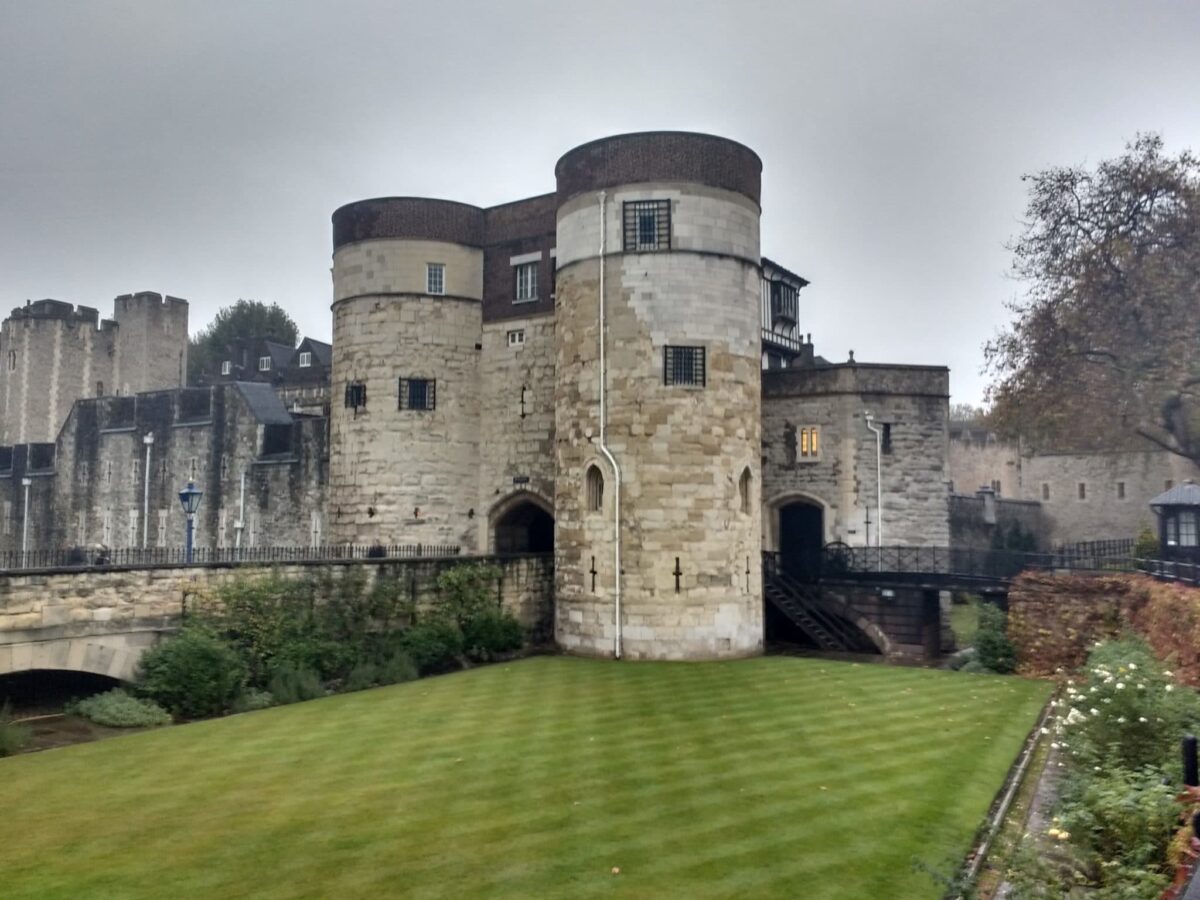
But William the Conqueror’s career began in the Calvados town of Falaise Normandy.
Château de Falaise – Normandy where it all began
Falaise Castle is a solid stone fortress dating from around 1000 it is around 3 hours from Paris. Built by the first Dukes of Normandy, it was enlarged by William after his conquest of England in 1066. In the 12th century, William’s descendants built two square typically anglo-norman keeps using the foundations of the original castle.
These buildings show the Dukes of Normandy at the height of their powers. They are the most sophisticated of the Royal Dukes’ palace/keeps and the best-preserved of their fortresses in France. Falaise is around a 2-hour journey from Paris.
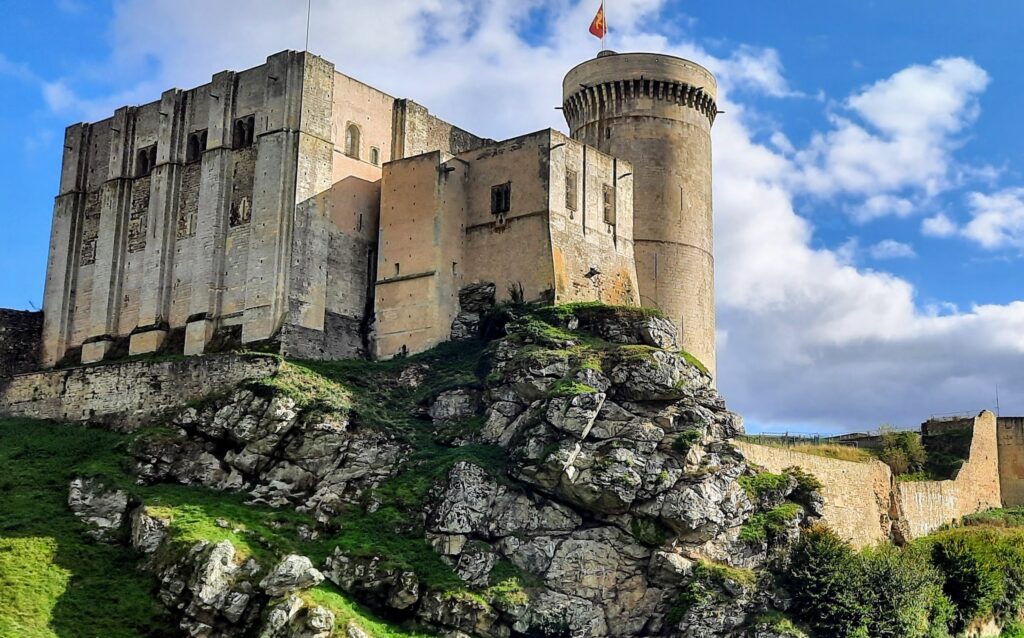
Before he was William the Conqueror, England’s first Norman king was known as William the Bastard. He was the illegitimate son of the Duke of Normandy, Robert the Magnificent was born in the Chateau de Falaise.
The massive walls and turrets that surround the chateau – parts of which are original – were not fanciful decorations but the sign of embattled times.
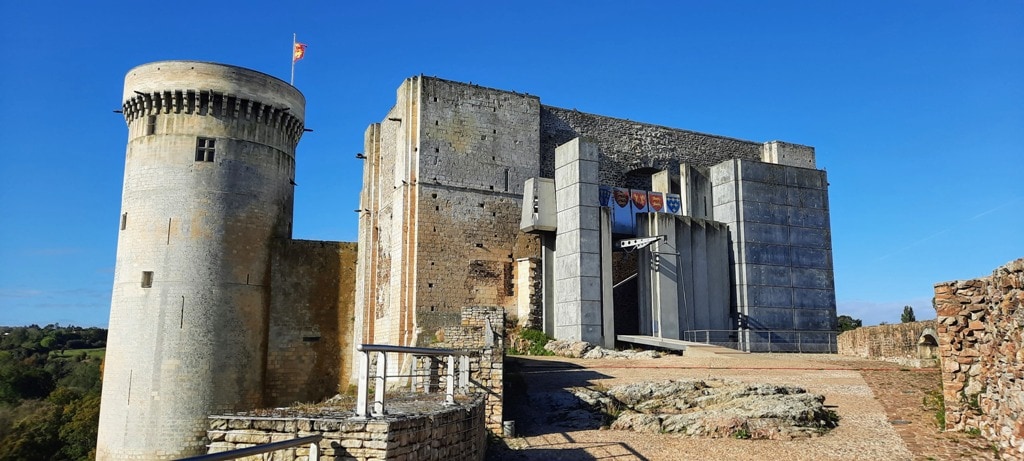
It’s not by accident that parts of it are reminiscent of Norman castles in England. Norman Connections, a European cross-border project, highlights the shared heritage of Falaise with castles in England – notably Norwich, Rochester, Hastings and Colchester.
The English designs of William’s architect, Gundulph, were often recreated in his Norman domains. The original castle keep at Falaise was modelled on the Tower of London and the current reconstruction resembles Norwich Castle.
Using pretty cool augmented reality brings the Middle Ages to life both inside and outside the castle. As you go through the castle you point an iPad at special viewers located throughout the castle. You will see the images transformed into what the castle looked like through the 11th-12th centuries.
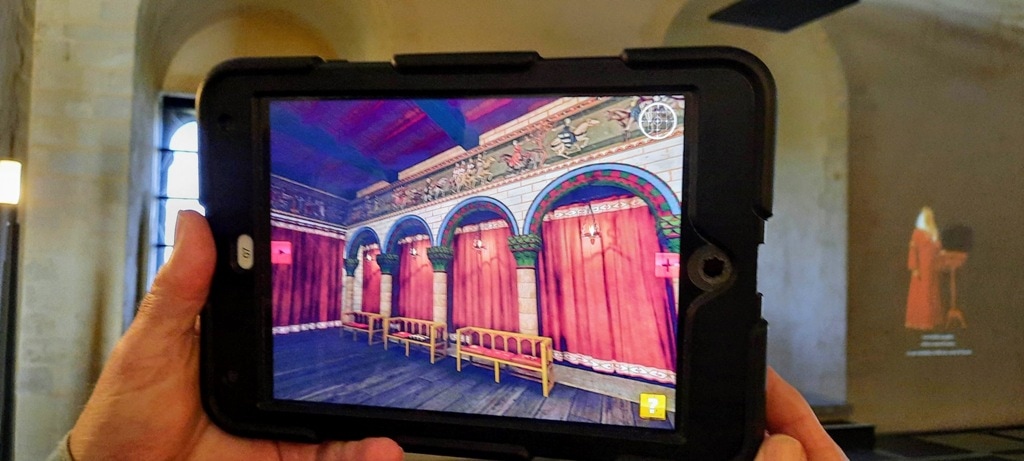
There are also projections of the people who lived at the Castle and you see these on the walls with narration in both English and French.
Look for Arlette’s Fountain on Rue de la Roche, behind the great rock on which the castle keep stands. Legend has it that Arlette, William the Conqueror’s mother, was washing clothes in the fountain when William’s father first saw her and chose her as his mistress.
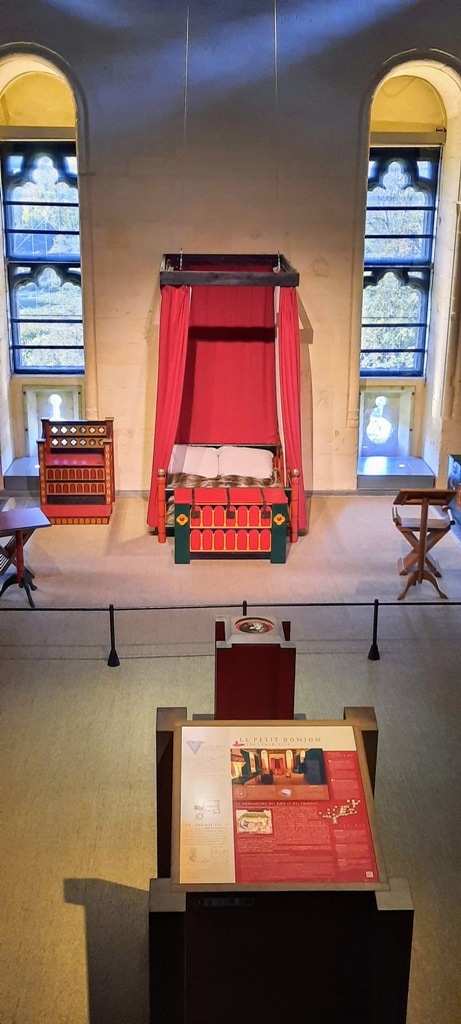
14 English Norman castles
How many Norman castles are there in England?
Historians believed that the Normans built 500 motte and bailey castles followed by the motte and keep castles in the first 20 years after the Battle of Hastings. Today 90 of these castles still exist, many in ruins and here are the 14 English Norman Castles you can visit.
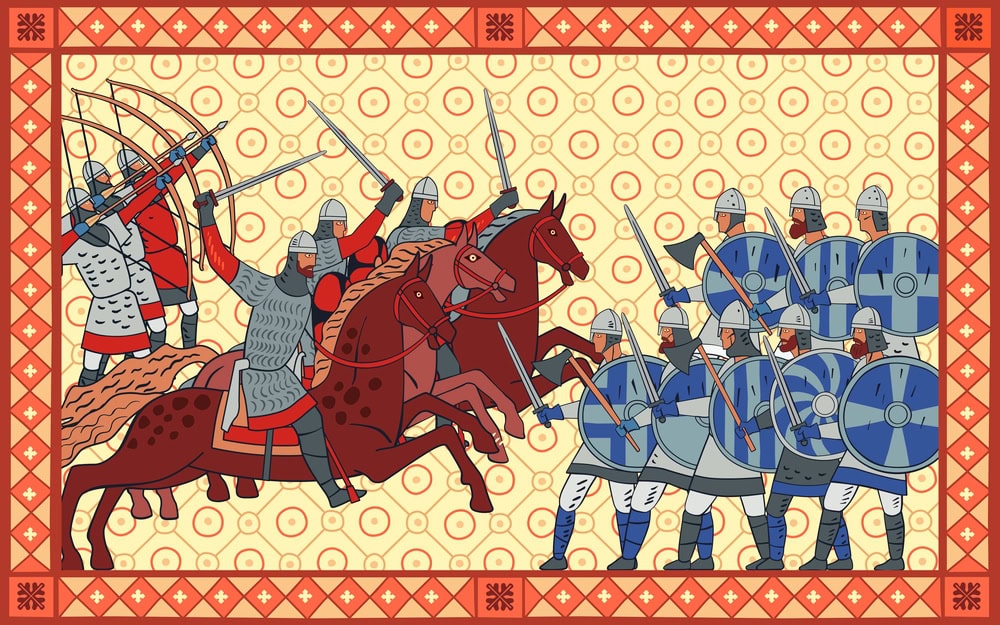
What was the difference between the Normans and the Anglo-Saxons? The Romans were the first group to conquer England and then after that came the Vikings. The Anglo-Saxons were essentially farmers who fought on foot on the battlefields when the conquering Normans, who fought in a strictly ruled army arrived. Essentially the Anglo-Saxons were in Britain first.
What was the difference between Anglo-Saxon castles and Norman castles? The Anglo-Saxon castles were not castles in the true sense of the world they were more ring forts and motte and bailey-style wooden castles not necessarily built for defence. The Normans came and built great stone castles around the original wooden structures and enhanced the military capacity for the defence of the area.
Hastings Castle – East Sussex
Which castle did William the Conqueror live in? Another early wooden Norman castle was built at Hastings next to the sea. This was built to create a base for William’s armies where they raided the English countryside prior to the Battle of Hastings.
Initially, Hastings Castle was built in wood and featured a wooden palisade, man-made earthwork motte, and outer bailey and when the Battle was one William ordered it to be upgraded to a stone keep.
There is a picture of Hastings Castle on the Bayeux Tapestry, its narrative states William the Conqueror “commands that a castle be dug at Hestengaceastra”. The castle is also mentioned in the Anglo-Saxon Chronicle and the Domesday Book (1086).
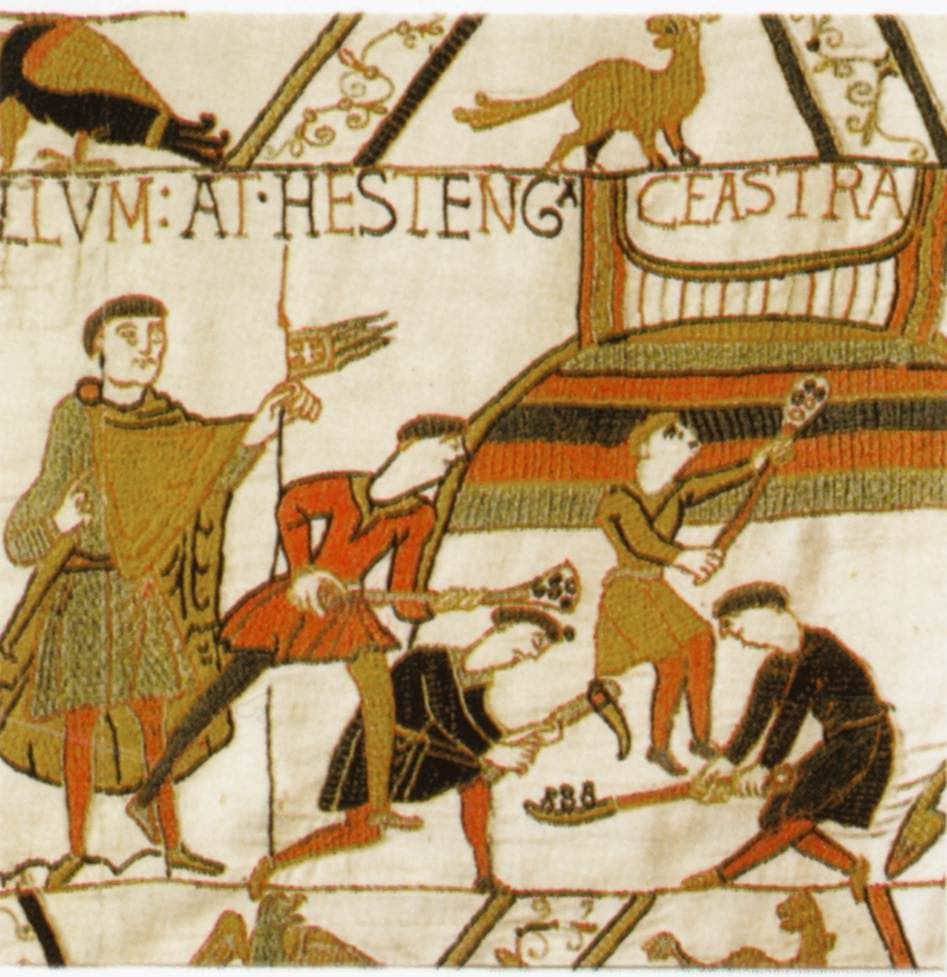
In 1287, violent storms battered the south coast for many months and the soft sandstone cliffs eventually eroded and large sections of the castle fell into the sea.
In 1216, during the reign of King John, the castle was deliberately destroyed to stop it from falling into the French hands of Prince Louis of France. There was considerable damage done but by 1220 Henry II ordered the repairs of the Castle, which was attached again by the French in 1339.
Throughout the next century, erosion was unchecked and gradually more of the castle was lost to the sea.
By the 1800s the Castle was buried in undergrowth and rubble but was finally revived as a Victorian tourist attraction as Hastings’ popularity as a holiday destination boomed. Later, during World War II, Hastings was heavily bombed and so an anti-aircraft gun was placed outside the Castle’s East Wall for protection.
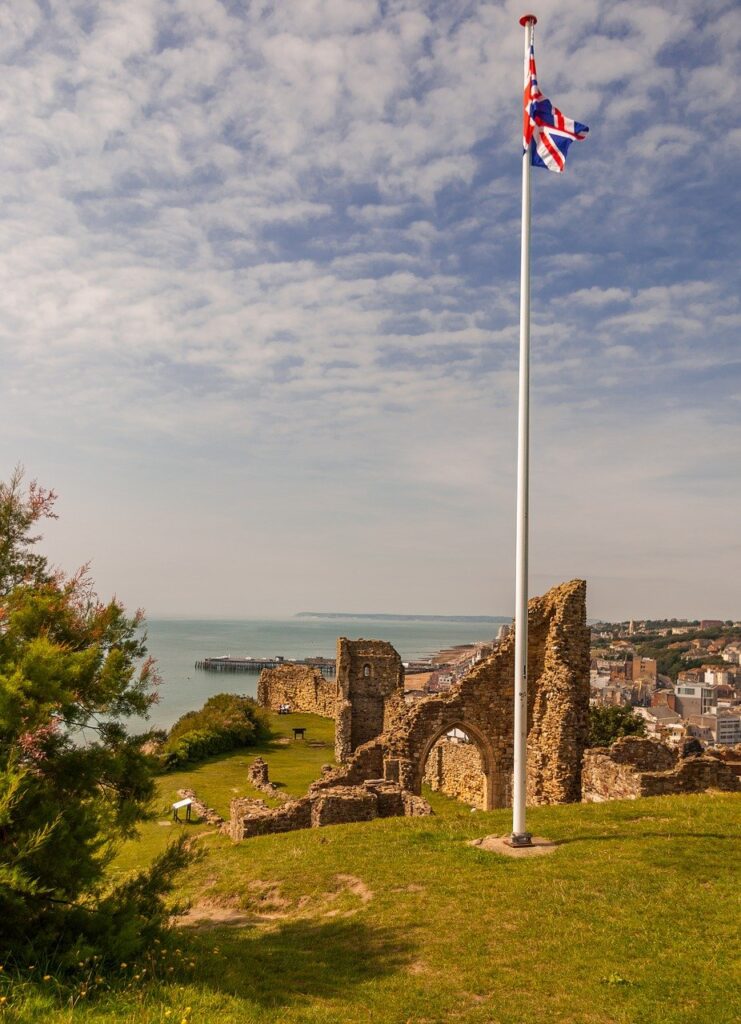
In 1951 the Castle was purchased by the Hastings Corporation for £3,000. Queen Elizabeth, who was Princess at the time, received the deeds which were then passed to the Mayor of Hastings. Work was carried out to make the Castle safe.
Very little of this castle exists today, just a few broken walls and crumbling stone structures atop a cliff that is accessible only by climbing 100 stairs or riding a steep railway. This is a trek meant only for the most intrepid tourist determined to track every step William took in his conquest of England
Rochester Castle – Kent
Another impressive survivor of the Conqueror’s castle ring is Rochester. The central tower here is probably one of the best-preserved Norman castle keeps in all of England. Dating from the late 12th century, it is also one of the tallest keeps in the country, soaring 113 feet. It covers 70 square feet, with walls that are 11 to 13 feet thick.
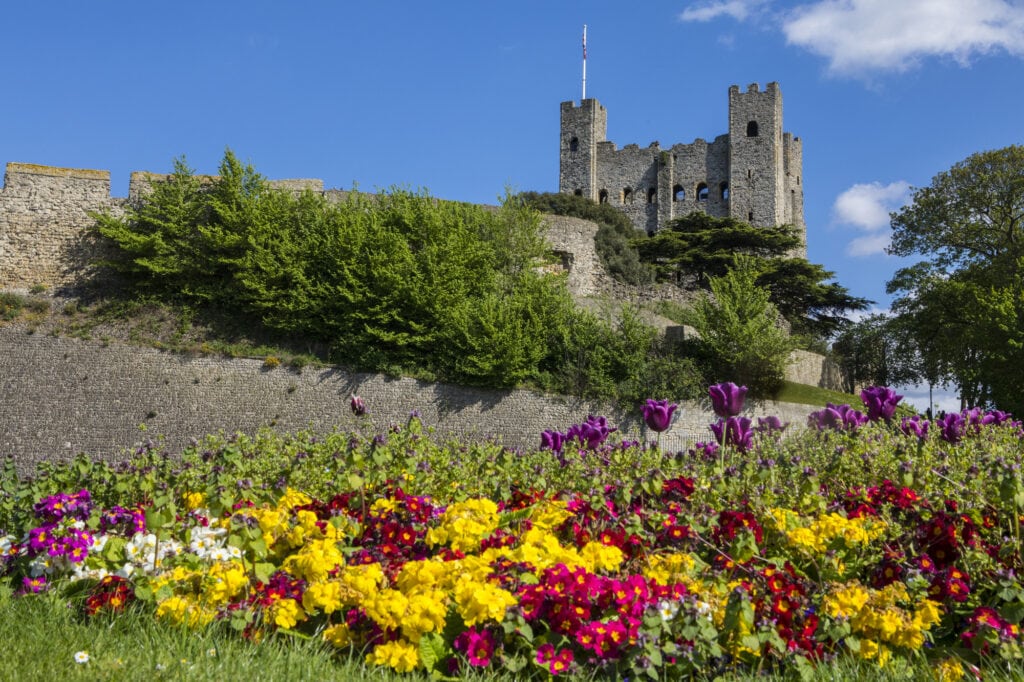
Sadly, the building is just a shell, the roofs and floors of the three floors that once divided the keep are gone, although a central wall that split the building in half remains. Still, visitors are permitted to enter the keep and, if you feel strong enough to tackle the steep, narrow, spiralling staircase that goes up to the battlements, you will see jaw-dropping views of the city and countryside.
Across from the Castle is Rochester Cathedral which was begun in 1080 by Bishop Gundulf who was Williams’ chief architect and designed the White Tower in London.
Pevensey Castle – East Sussex
The first motte and bailey castle built by William the Conqueror was built in Pevensey, Sussex. Almost immediately after landing in September 1066, William ordered the construction of a motte-and-bailey castle at Pevensey. This Castle was built on the foundations of a Roman fort which is believed to have been built in 290AD.
The new castle was built inside the Roman fort and it had a curtain wall that included round towers. This space inside the newly built area was called the inner bailey and the space between the old and new areas was the outer bailey where functional buildings for storing grains, and food were kept.
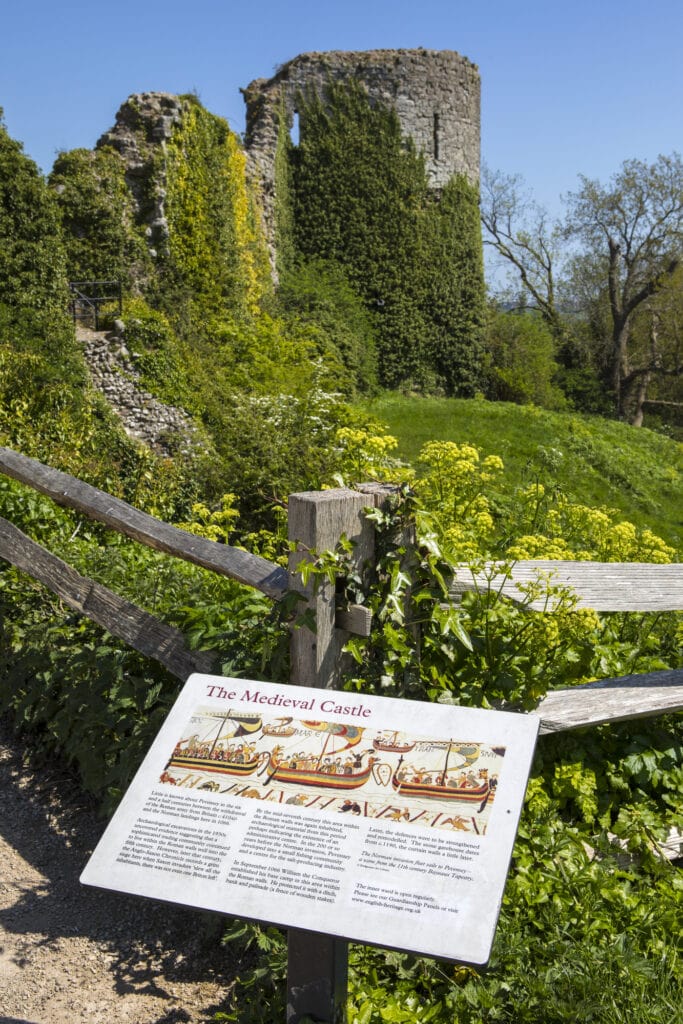
With the original construction being made of wood not surviving the stone fort that stands today dates back to the 13th century. The interior has obviously not survived but archaeologists assume that it included a chapel and a kitchen and may have been up to 25 metres high. There was also a moat surrounding the castle spanned by a wooden bridge.
Dover Castle – Kent
After the Battle of Hastings William, the Conqueror moved onto Dover to capture the port. It is believed that William established some kind of fortification here but there are no surviving remains of it. Dover Castle was extended in the 12th century but nothing is known about its appearance prior to then.
The castle you see today was built by Henry II who spent money lavishly on Dover’s castle design. The immensely powerful castle combined defence with a palace of residence.
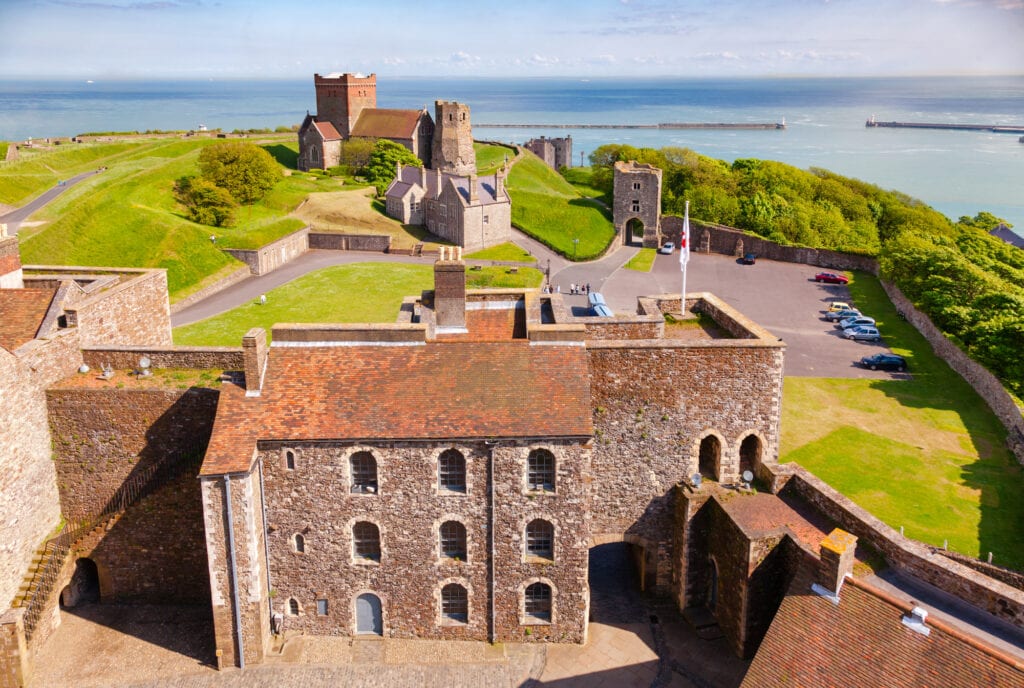
The origin of settlement on Castle Hill, where Dover Castle stands today was probably a pagan hillfort that was taken over by the Romans when they invaded around the 1st century. The Romans built a lighthouse tower on Castle Hill and another on the opposite hill Western Heights.
The lighthouse was later reused in the building of the church of St Mary in Castro as a chapel and bell tower, and can still be seen there today.
The Tower of London – a Norman Keep
Before his coronation in London troops were sent ahead of the royal party to capture the city and build a castle. A simple wooden castle was built at the southeastern corner of London’s Roman walls. Soon after the wooden castle was built the workers began upgrading it to a stone building.
Strategically situated to defend London from invaders the location of the Tower of London on the Thames was carefully chosen.
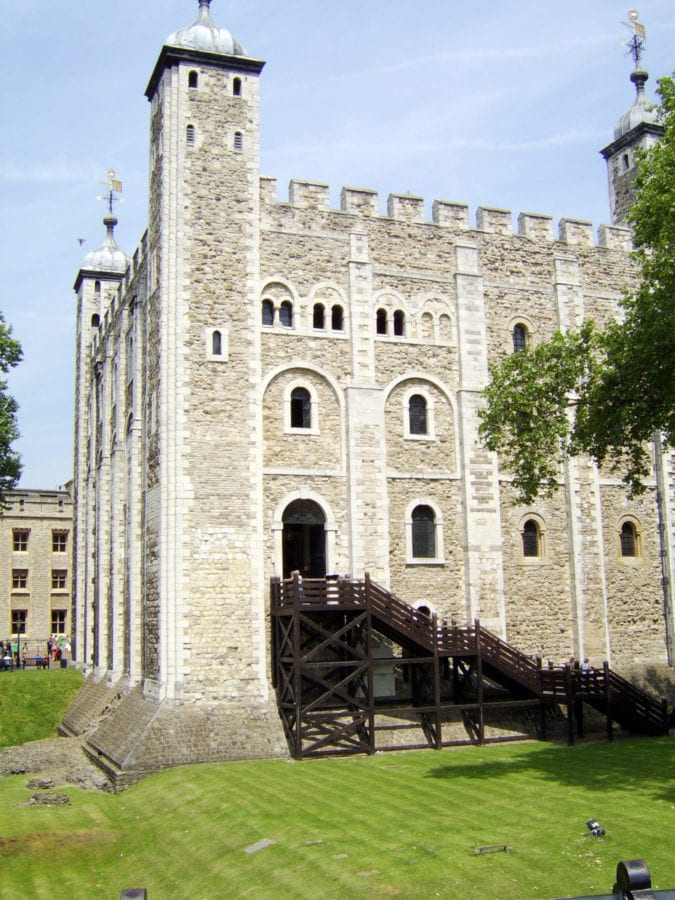
The White Tower is the original Norman Keep on the Tower site and initially, it used stone from Kent and Caen limestone which was later replaced with Portland stone.
The White Tower was an accommodation fit for a king in its luxurious features and fittings but it wasn’t finished until after William’s death in 1087.
Windsor Castle – Berkshire
It was William who chose the site for Windsor Castle, which was on the edge of an Anglo-Saxon hunting ground on a hill high above the river Thames. The castle was begun in 1070 and took 16 years to finish.
Windsor was to guard the western approach to London and was one of several castles built around London’s perimeter. William never lived at Windsor as the Norman kings preferred to use the Palace of Edward the Confessor.
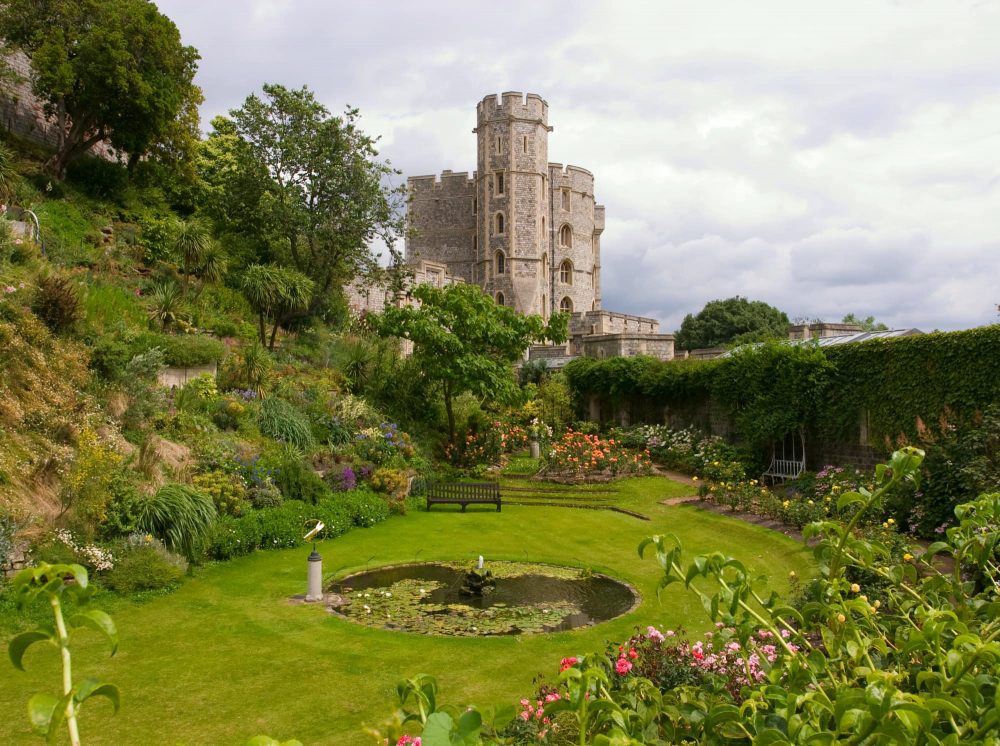
It was Henry I who was the first King to use Windsor as a royal residence, and his grandson Henry II converted the Castle into a palace in the late 12th century. Henry II replaced the wooden castle with stone and re-built the Round Tower in 1170.
Henry III completely re-built Henry II’s buildings and added a large new chapel set around a courtyard with a cloister.
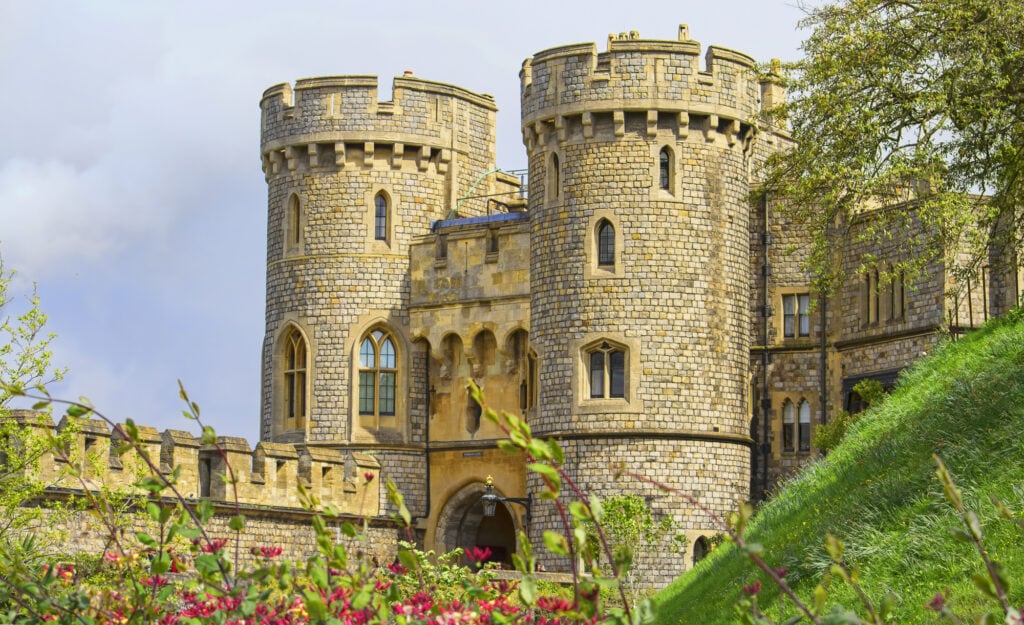
During the First World War, the British Royal Family were known as the House of Saxe-Coburg-Gotha, and in order to remove themselves from the taint of a Germanic name, they adopted the name Windsor in 1917.
Norwich Castle – Norfolk
Norwich is believed to be the oldest English castle and historians believe that in 1067 William began a campaign to control the potential for rebellions in East Anglia and that Norwich Castle was built then. William had Caen limestone imported from Normandy and had 98 Saxon houses and two churches destroyed to make space for the Castle. He also had a Bishop move from Normandy to Norwich to take charge of building a Cathedral using the best quality French limestone.
At that time the castle would have been a wooden keep but by the 11th century, the stone keep that exists today was finished. The finished castle was definitively Norman with its crenellations, small windows and buttresses.
In 1087 when William II dies, the building of the stone keep is continued by his brother, Henry I. The stone keep is completed by 1121 and the building was intended to be a royal palace. It is thought that Henry I stayed at the castle during a crown-wearing ceremony at Christmas.
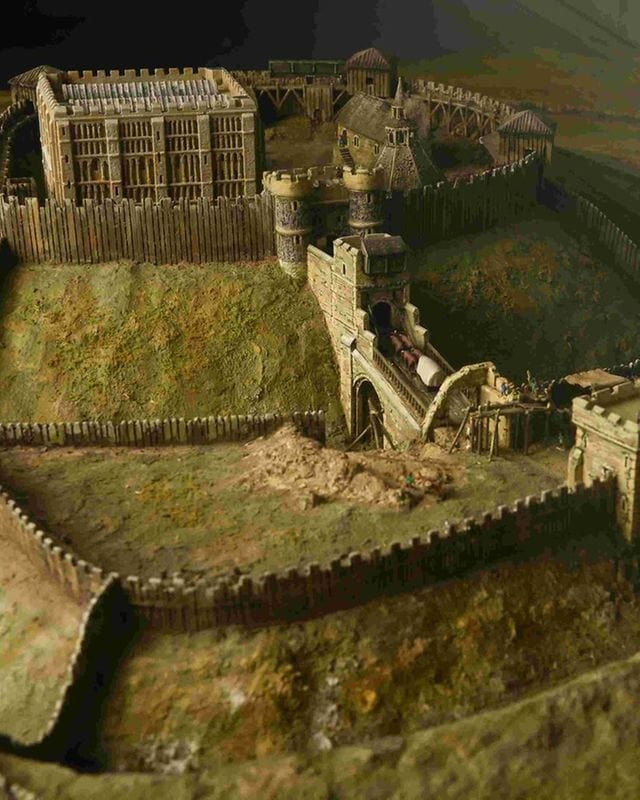
The Castle and its keep serve as a royal residence as well as a centre for legal and financial rule over the region from 1121 until the 1300s. By the mid-1300s the castle is used as a prison until the end of the 19th century.
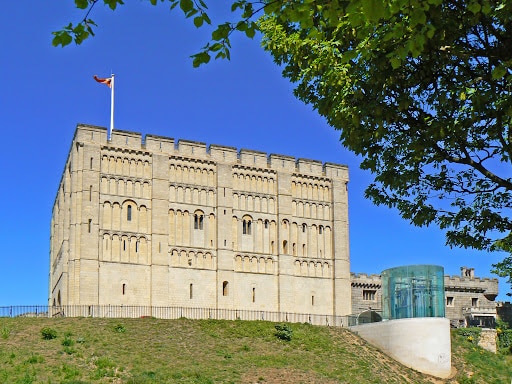
It wasn’t until 1888 that a decision was made to restore the castle and use it as a museum. The castle museum was opened in 1894 by the Duke and Duchess of York, later King George V and Queen Mary. In 2020 work began on the site to restore the castle to its former medieval glory.
Warwick Castle – Warwickshire
Warwick Castle sits proudly on a sandstone bluff at a bend of the River Avon. The river, which runs below the castle on the east side, has eroded the rock the castle stands on, forming a cliff. The river and cliff form natural defences.
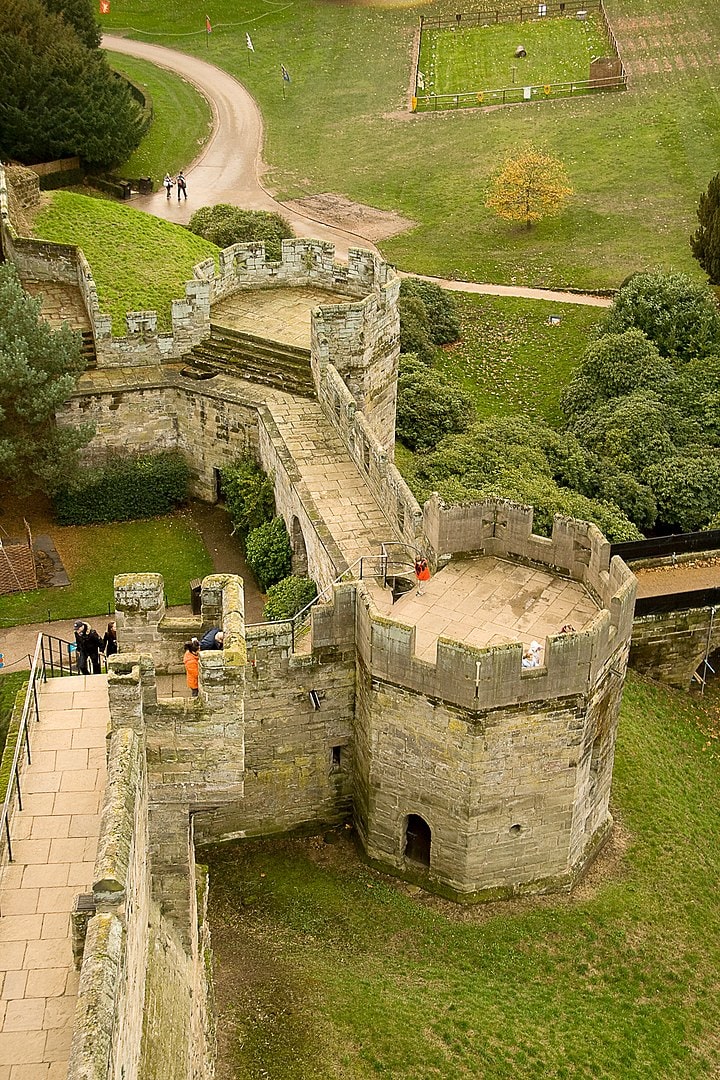
It was in 1068 that William the Conqueror built a motte and bailey which was a wooden fortification on the hilltop. In the 12th century, a stone castle replaced the wooden fortification and it became one of Britain’s most impressive strongholds.
York Castle – Clifford’s Tower – York
Clifford’s Tower is almost all that remains of York Castle built by William the Conqueror. York had been a crucial Viking stronghold and it was important to William to protect the territory against rebellions so a Castle was commissioned.
In 1068 a simple wooden motte-and-bailey castle was constructed with a motte around 61 metres wide at its base. William also built another castle opposite the first one on Baile Hill. However, both castles were captured and destroyed by the Vikings in late 1069.
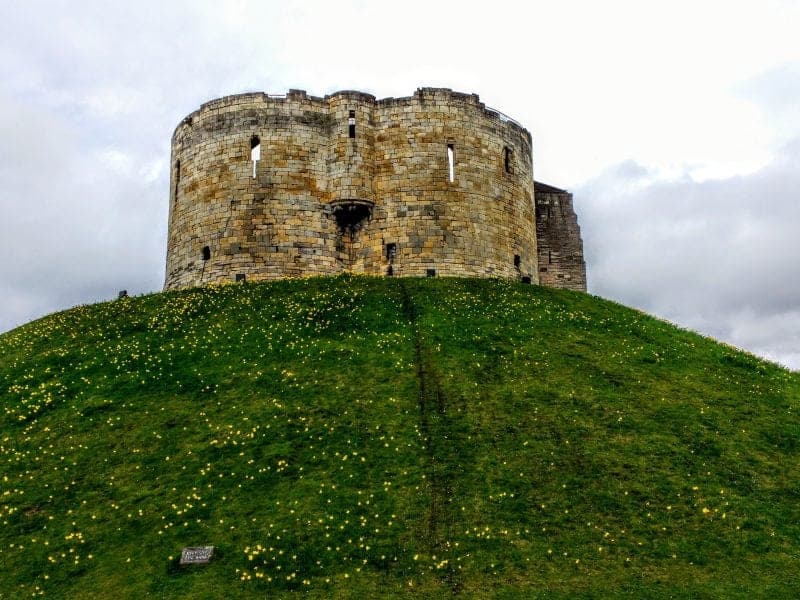
A stone keep was later built on the first site but it had much greater defences that included a moat and lake.
York Castle was the location of one of England’s most infamous events. In 1190 tensions were exacerbated by the Crusaders whose propaganda against Muslims and Jews caused riots in the city.
After King Richard I’s coronation in 1189, a rumour was begun that he had ordered the massacre of the Jews. The rumour was untrue but a progrom began that resulted in the deaths of 150 jews most of whom committed suicide took place.
The entire Jewish community of York who had taken refuge in the royal castle where Clifford’s Tower now stands were dead within minutes. The chronicler William of Newburgh described the rioters as York acting “without any scruple of Christian conscientiousness” in wiping out the Jewish community.
Arundel Castle – West Sussex
Arundel Castle is located in West Sussex and was built on the foundations of an Anglo-Saxon fortification. Arundel Castle was the work of the Norman knight Roger de Montgomery who was a friend of William the Conqueror.
Roger was told to defend the southern coast and build a castle to protect William’s interests. The original castle was a motte with two baileys built on a 90-foot high mound surrounded by a ditch. The castle remained in the Montgomery Family until 1102 when forces under Henry I forced the surrender of Robert de Belleme the owner at the time.
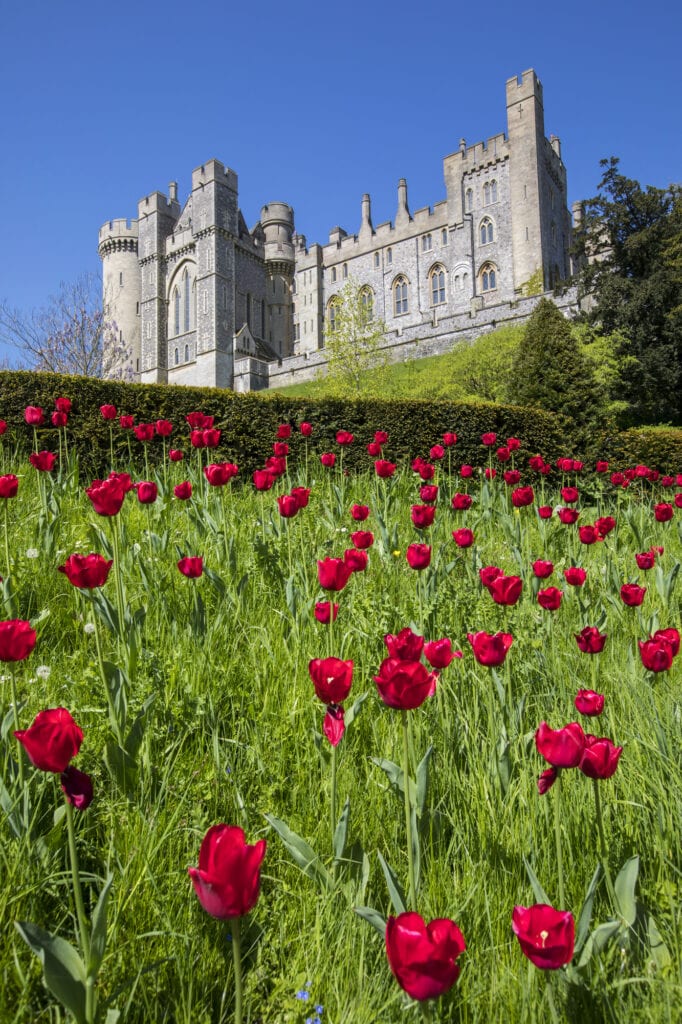
At this point, the castle became a royal stronghold. The original wooden fortification by then had been replaced by stone. The circular keep was possibly begun by Robert de Belleme and finished by Henry I when he took control of the castle.
Chepstow Castle – Monmouthshire
After the Battle of Hastings in 1071 William named Lord William Fitz Osbern of Breteuil the Earl of Hereford and sent him to the Welsh borderlands of Monmouthshire to subdue the Welsh and build a castle. Osbern chose a location on a limestone promontory overlooking the River Wye
Chepstow was the gateway into and Osborn began the building he dies in 1071 and because his son betrayed William Chepstow passed back to the Crown.
Chepstow was one of the earliest castles built in stone, with a magnificent Norman Tower built in the heart of the castle. The tower still dominates the landscape today standing 120 long and 45 feet wide.
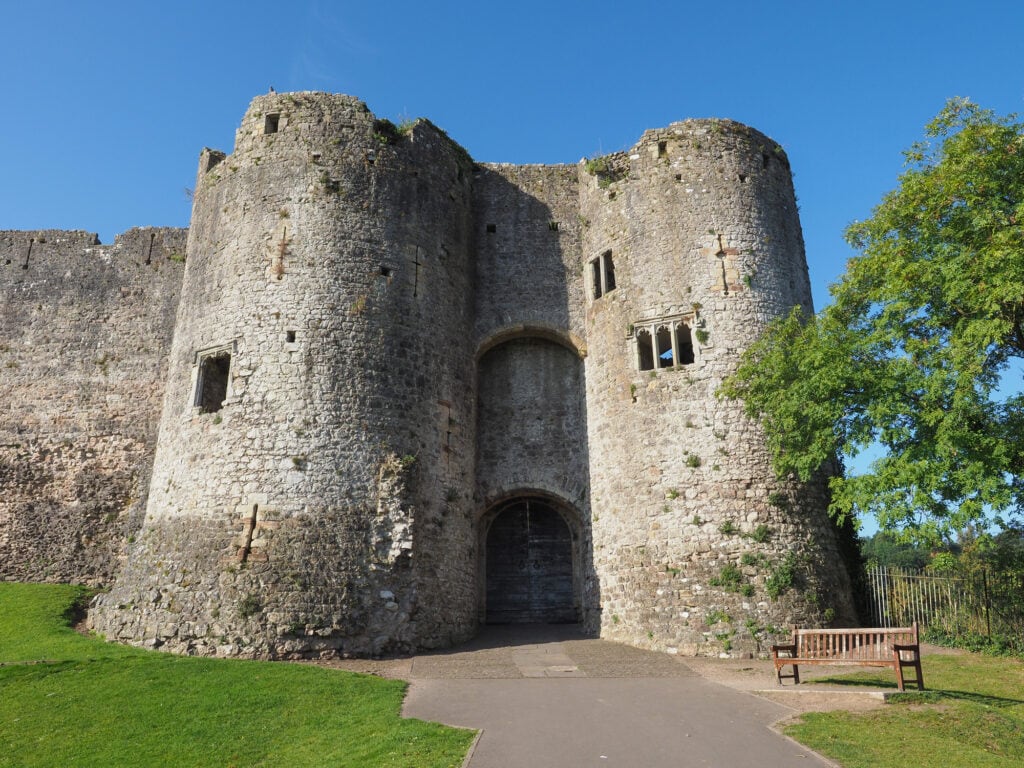
Chepstow originally housed a large cellar, a chapel and a latrine and was expanded upon by later owners. In 1115 King Henry I Granted Chepstow Castle to the Irish de Clare family. In 1176 Earl Richard de Clare known as Strongbow died and left the estate including vast areas in England, Ireland and Normandy to his daughter Isabella but Chepstow was returned to the King.
By 1189 Richard the Lionheart arranges the marriage of Isabella de Clare to his father’s loyal knight William Marshal and he is given Chepstow.
Colchester Castle – Essex
Colchester Castle is a large Norman fortification in Essex built on the site of an old Roman temple of Claudius. William ordered the Castle to be built around 1070 and the builders re-used the foundations and plinth of the old Roman construction. As a result, Colchester’s keep is the largest of all medieval towers in Europe.
The area of Colchester has no natural stone that can be used for building so re-using the Roman stones made building easier. It also associated the Normans with the Roman’s as a successor to the power of Caesar. This re-using of stone meant that the castle was situated closer to the centre of town which was unusual in those times.
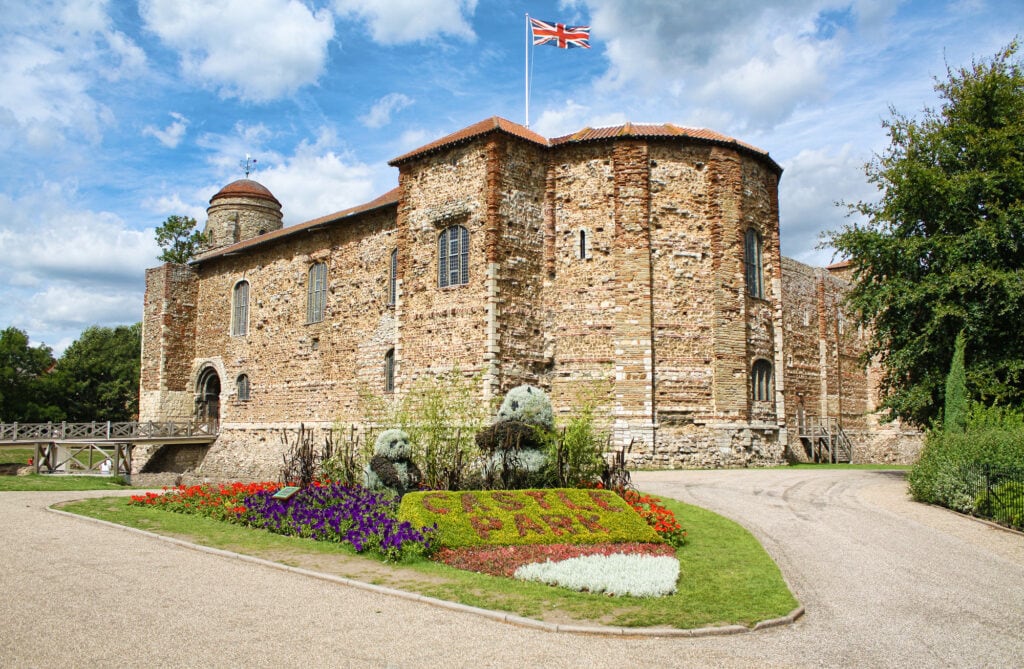
There was a large ditch possibly a moat surrounding the castle and several Norman structures can be seen today. There is an archway of Caen stone at the entrance and a large winding staircase in the southwest tower along with the y – shaped chimneys that stand today.
Durham Castle – Durham
Durham was begun in 1072 on the orders of William the Conqueror following his journey to the North earlier that year. The structure itself was built using local stone cut from the nearby cliffs.
Durham is a classic Norman motte-and-bailey castle – it may have been built of wood initially but was certainly upgraded to a stone keep later on.

Waltheof, Earl of Northumberland, oversaw construction until his rebellion and execution in 1076, after which Walter, the Bishop of Durham, completed the construction work. Durham was crucial to controlling the Scottish border, as well as dealing with rebellions in the North.
Sitting at the heart of Durham’s World Heritage Site and occupied continuously since the 11th century, the Castle is now home to the students of University College, part of Durham University.
Corfe Castle – Dorset
William the Conqueror built the castle we see today in the late 11th century in stone and made it one of the most important castles in the defence of his new kingdom. It guards the gap between the south of Purbeck, where Purbeck marble was once quarried, and the rest of England. Nothing could pass in or out without going past the Castle.
Legend tells that when an Anglo-Saxon hall stood on the site, the young Edward the Martyr was murdered there in 978 during a plot to position his half-brother Ethelred ‘the Unready’ as monarch. Edward was later canonised, with his feast day falling on the anniversary of his death – 18 March.
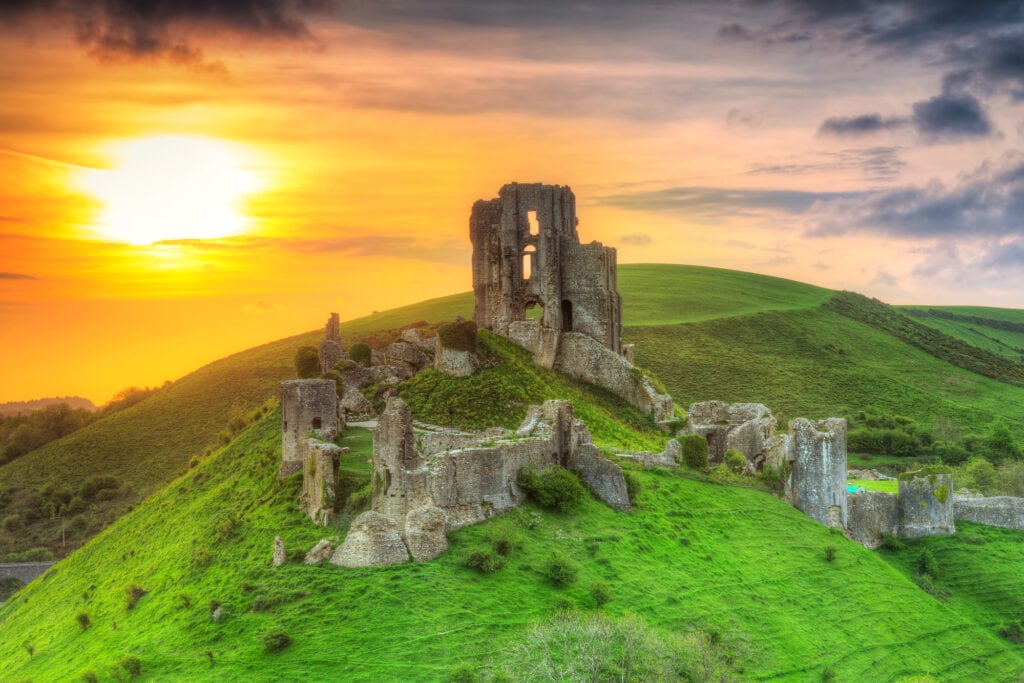
It was in the 12th century Edward I built the imposing keep, and further altered and added to it in the 13th century under King John. Not only did John further fortify the castle, but he also used it as a prison and royal residence. Sold by Elizabeth I in 1572, Corfe Castle became a grand private home, first to Sir Christopher Hatton and later by Sir John Bankes in 1635.
In 1645, the Parliament ordered its Slighting during the English civil war which meant that it was ruined so it couldn’t be used as a military building. Its ruins were eventually handed back to the Bankes family, who retained it for 350 years before in 1982 gifting it to the National Trust.
Remnants of five more castles of William’s circle of nine can be found at Canterbury, Oxford, Wallingford, Hertford and Berkhamsted. In Canterbury, ruins of the stone fortress built here sometime between 1070 and 1094 can be found on Castle Street. All that is left of the mighty castle that once stood in Oxford is the original motte and St. George’s Tower.
Exploring the impressive legacy of William the Conqueror’s castles, which still stand as a testament to his military prowess and architectural genius is a must-do for any amateur historian.
Articles on Castles in Europe to read
11 of the best castles in Wales to visit
Castles of the Loire Valley France
Visiting Mont St Michel the ultimate guide to this UNESCO site
33 of the most fabulous Hotel Castles to stay in Ireland
Visiting Bunratty Castle Ireland
Castles of the Loire Valley France
How many of William the Conqueror’s Castles have you seen so far?
